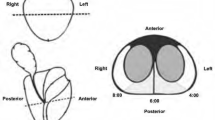Summary
To distinguish prostatic dysplasia (or adenosis) from well differentiated adenocarcinoma on transrectal needle biopsy, a morphometric study was conducted on 20 cases of adenosis and 20 cases of well differentiated adenocarcinoma of the prostate. About 100 cells for each patient were analyzed by means of a computerized image analyzer, and mean nuclear diameter, mean nuclear area, mean form factor and number of cells in eight classes of nuclear diameter were studied. The best predictors of malignancy (evaluated by means of Receiver Operating Characteristics curves) were mean nuclear area >28μ2, presence of more than 5% of cells with nuclear diameter>6.15 μ, and mean nuclear diameter>μ. Using these diagnostic criteria the probability of malignancy for a positive specimen rises from 14% (pre-test) to 75% (post-test).
Similar content being viewed by others
References
Brawn PN (1982) Adenosis of the prostate. A dysplastic lesion that can be confused with prostate adenocarcinoma. Cancer 49:826–833
Brawn PN (1984) Interpretation of prostate biopsies. Raven Press, New York, pp 44–47
Bocking A, Kiehn J, Heinzel Wach M (1982) Combined histologic grading of prostatic carcinoma. Cancer 50:288–294
Byar DP (1972) Survival of patient with incidentally found microscopic cancer of the prostate: results of a clinical trial of conservative treatment. J Urol 108:908–913
Diamond DA, Berry SJ, Jewett HJ, Eggleston JC, Coffey DS (1982) A new method to assess metastatic potential of human prostate cancer: relative nuclear roundness. J Urol 128:729–734
Gschwind R, Umbricht CB, Torhorst J, Oberholzer M (1986) Evaluation of shape descriptors for the morphometric analysis of cell nuclei. Pathol Res Pract 181:213–222
Kastendieck H, Altenahr E, Husselmann H, Bressel H (1976) Carcinoma and dysplastic lesions of the prostate. A histomorphological analysis of 50 total prostatectomies by stepsection technique. Z Krebsforsch 88:33–54
McNeal JE (1970) In: Griffiths K, Pierrepoint CG (eds) Some aspects of the aetiology and biochemistry of prostatic cancer. Alpha Omega, Cardiff, pp 23–32
Nesbit RM, Baum WC (1951) Management of occult prostatic carcinoma. J Urol 65:890–894
Purser BN, Robinson BC, Mostofi FK (1967) Comparison of needle biopsy and transurethral resection biopsy in the diagnosis of carcinoma of the prostate. J Urol 98:224–228
Seidmann H, Silverberg E, Bodden A (1978) Probabilities of eventually developing and dying of cancer 28:33–46
Weinstein MC, Fineberg HV (1980) Clinical decision analysis. Saunders, Philadelphia
Author information
Authors and Affiliations
Additional information
Supported by a grant from “Associazione Italiana per la Ricerca sul Cancro”
Rights and permissions
About this article
Cite this article
Aragona, F., Franco, V., Rodolico, V. et al. Interactive computerized morphometric analysis for the differential diagnosis between dysplasia and well differentiated adenocarcinoma of the prostate. Urol. Res. 17, 35–40 (1989). https://doi.org/10.1007/BF00261048
Accepted:
Issue Date:
DOI: https://doi.org/10.1007/BF00261048




